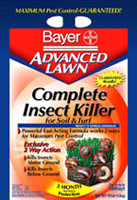You don't the permission to view this video
 Controls a variety of insects that destroy healthy lawn turf.
Controls a variety of insects that destroy healthy lawn turf.- The active ingredient in some pesticides will remain active for months, eliminating the need for multiple applications.
- Some products can be sprayed on while others are incorporated into a fertilizer in granular form.
- Insects attacking lawns can be all shapes, colors and sizes, but they generally fall into two categories: surface-active (above ground) and soil active (below ground).
- Examples of surface-active bugs are webworms, cutworms, army worms andchinch bugs.
- Sod webworms damage lawns throughout the entire growing season by eating grass blades. Small moths flying in zigzag patterns across the lawn are a good indication these bugs are present.
- Chinch bugs damage lawns when temperatures rise above 80°F. They attack grass stems and suck out plant juices. Lawns usually have to be reseeded.
- Grubs are an example of soil active insects. They feed on grass roots, killing the grass in patches. White grubs become active when the soil warms up and they destroy lawns from late spring to early fall.
- Many insects do not pose problems to lawns. Before you decide to use a pesticide, determine that the number of pests and potential damage and environmental impact justify the use of a pesticide.



Comments (0)